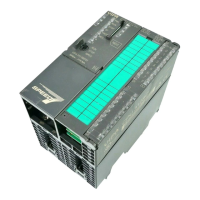tents of record set 0 are already in the local double word 8 when
calling the OB 82. The SFC 59 allows you to also read the record set
1 that contains additional information. After leaving the OB 82 a clear
assignment of the data to the last diagnostic interrupt is not longer
possible. The record sets of the diagnostic range have the following
structure:
Byte Bit 7...0
0
n Bit 0: set at module failure
n Bit 1: 0 (fix)
n Bit 2: set at external error
n Bit 3: set at channel error
n Bit 7 ... 4: 0 (fix)
1
n Bit 3 ... 0: Module class
–
0101b: Analog
– 1111b: Digital
n Bit 4: Channel information present
n Bit 7 ... 5: 0 (fix)
2
n Bit 7 ... 0: 0 (fix)
3
n Bit 5 ... 0: 0 (fix)
n Bit 6: Process interrupt lost
n Bit 7: 0 (fix)
After the removing error a diagnostic message
outgoing
takes place if the
diagnostic interrupt release is still active.
Byte Bit 7...0
0
n Bit 0: set at module failure
n Bit 1: 0 (fix)
n Bit 2: set at external error
n Bit 3: set at channel error
n Bit 7 ... 4: 0 (fix)
1
n Bit 3 ... 0: Module class
–
0101b: Analog
– 1111b: Digital
n Bit 4: Channel information present
n Bit 7 ... 5: 0 (fix)
2 00h (fix)
3 00h (fix)
The record set 0 of the counter function, frequency meas-
urement and pulse width modulation has the same struc-
ture. There are differences in the structure of record set 1.
Record set 0 Diag-
nostic
incoming
Record set 0 Diag-
nostic
outgoing
VIPA System 300SDeployment I/O periphery
Diagnostic and interrupt > Diagnostic interrupt
HB140 | CPU-SC | 313-6CF13 | GB | 15-50 142

